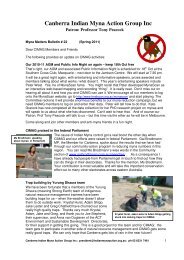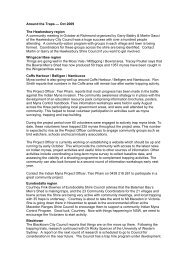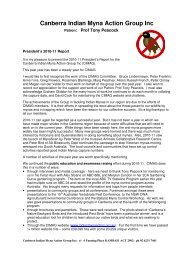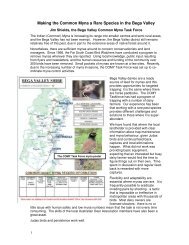The use of petrol engine exhaust fumes - Canberra Indian Myna ...
The use of petrol engine exhaust fumes - Canberra Indian Myna ...
The use of petrol engine exhaust fumes - Canberra Indian Myna ...
Create successful ePaper yourself
Turn your PDF publications into a flip-book with our unique Google optimized e-Paper software.
<strong>The</strong> <strong>use</strong> <strong>of</strong> <strong>petrol</strong> <strong>engine</strong> <strong>exhaust</strong> <strong>fumes</strong><br />
for the euthanasia <strong>of</strong> trapped birds<br />
<strong>The</strong> trapping <strong>of</strong> large numbers <strong>of</strong> pest birds such as the <strong>Indian</strong> <strong>Myna</strong> has resulted in a<br />
growing demand for humane and cost-effective methods <strong>of</strong> euthanasia. <strong>The</strong> <strong>use</strong> <strong>of</strong> <strong>petrol</strong><br />
<strong>engine</strong> <strong>exhaust</strong> <strong>fumes</strong> for the gassing <strong>of</strong> trapped birds has received most support<br />
beca<strong>use</strong> <strong>of</strong> its ease <strong>of</strong> application and availability. A recent study by Tidemann and King. 1<br />
supports this approach. In October 2005, NSW DPI published a series <strong>of</strong> Codes <strong>of</strong><br />
Practice and Standard Operating Procedures 2 for the humane control <strong>of</strong> pest animals.<br />
One <strong>of</strong> these documents (Methods <strong>of</strong> Euthanasia GEN 001) did not support the <strong>use</strong> <strong>of</strong><br />
car <strong>exhaust</strong> <strong>fumes</strong> as per the following statement:<br />
“Exhaust from idling internal combustion <strong>engine</strong>s is NOT an acceptable<br />
euthanasia agent as adequate CO concentrations cannot be achieved<br />
(particularly with modern car <strong>engine</strong>s) and <strong>exhaust</strong> contaminants such<br />
as hydrocarbons, ozone, nitrogen dioxide and nitric oxides ca<strong>use</strong> severe<br />
irritation before death. Exhaust gases may also be unacceptably hot.”<br />
In light <strong>of</strong> the Tidemann and King paper, there has been a call for this document to be<br />
amended and for inclusion <strong>of</strong> <strong>exhaust</strong> <strong>fumes</strong> from all types <strong>of</strong> <strong>petrol</strong> <strong>engine</strong>s as an<br />
acceptable method <strong>of</strong> euthanasia. <strong>The</strong>re are a number <strong>of</strong> practical reasons why this call<br />
would be worthy <strong>of</strong> support. However, there are also some points <strong>of</strong> issue that still remain<br />
before this could occur for all types <strong>of</strong> <strong>petrol</strong> <strong>engine</strong>s.<br />
<strong>The</strong> humaneness and efficacy <strong>of</strong> carbon monoxide (CO) as a gaseous euthanasia agent<br />
is highly dependent on the source <strong>of</strong> which four are readily available:<br />
i) Carbon monoxide from a commercially compressed cylinder is<br />
acceptable beca<strong>use</strong> it induces loss <strong>of</strong> consciousness without pain or discernable<br />
discomfort and death occurs rapidly if the right concentration is achieved.<br />
However, CO cylinders would not be readily available for such <strong>use</strong> due to OH&S<br />
issues.<br />
ii) Carbon monoxide sourced from the cooled <strong>exhaust</strong> <strong>of</strong> non-vehicular<br />
<strong>petrol</strong> <strong>engine</strong>s without a catalytic converter (e.g. lawn mower or whipper<br />
snipper <strong>engine</strong> or purpose-built CO generator) appears to be acceptable since<br />
the level <strong>of</strong> carbon monoxide remains high and results in a rapid death. However,<br />
the literature suggests that contaminants such as hydrocarbons in the <strong>fumes</strong> can<br />
be irritating to the eyes and airways which makes the efficiency <strong>of</strong> delivery<br />
important.<br />
iii) Carbon monoxide sourced from the cooled <strong>exhaust</strong> <strong>of</strong> vehicular <strong>petrol</strong><br />
<strong>engine</strong>s with a catalytic converter i.e. from cars less than approximately 10<br />
years old is not acceptable on the basis <strong>of</strong> all current information. For example,<br />
research has shown that the levels <strong>of</strong> carbon monoxide drop <strong>of</strong>f very quickly after<br />
1 Tidemann, C. R. and D. H. King (2009). "Practicality and humaneness <strong>of</strong> euthanasia <strong>of</strong> pest<br />
birds with compressed carbon dioxide (CO2) and carbon monoxide (CO) from <strong>petrol</strong> <strong>engine</strong><br />
<strong>exhaust</strong>." Wildlife Research 36: 522-527.<br />
2 Sharp, T., and Saunders, G. (2005).'Humane pest animal control: codes <strong>of</strong> practice and<br />
standard operating procedures.' (New South Wales Department <strong>of</strong> Primary Industries:<br />
Orange)<br />
Vertebrate Pest Research Unit, Orange Agricultural Institute,<br />
Forest Rd., Orange NSW 2800
the <strong>engine</strong> has started, leaving only a small window where concentration is<br />
adequate for a rapid death (i.e. for up to approx 60 seconds after a car has been<br />
cold started). It is also likely that the level <strong>of</strong> potential irritants e.g. carbon, are<br />
highest during this short time.<br />
iv) Carbon monoxide sourced from the cooled <strong>exhaust</strong> <strong>of</strong> older vehicles<br />
without catalytic converters may be acceptable but would still have welfare<br />
concerns due to a high variability in the age and condition <strong>of</strong> <strong>engine</strong>s and<br />
presence <strong>of</strong> contaminants.<br />
To summarise, it appears that GEN 001 could be now be modified to include the <strong>use</strong> <strong>of</strong><br />
CO sourced from non-vehicular cooled <strong>petrol</strong> <strong>engine</strong>s without catalytic converters i.e.<br />
point ii) above. Some standard recommendations on filtering and cooling equipment,<br />
methods <strong>of</strong> introduction <strong>of</strong> <strong>fumes</strong> and operator competency would need to be devised.<br />
However there are remaining welfare concerns in relation to car <strong>exhaust</strong>s (with and<br />
without catalytic converters) which remain unresolved and prevent their inclusion at this<br />
stage.<br />
Standard Operating Procedures such as GEN 001 are nationally endorsed documents<br />
and before publication are required to be available for scrutiny by a wide range <strong>of</strong><br />
stakeholders. NSW Industry and Investment cannot make a unilateral decision to change<br />
these documents without the same process being repeated. It is not the purpose <strong>of</strong> this<br />
Research Unit to hinder the implementation <strong>of</strong> humane pest animal control techniques.<br />
However, it is our responsibility to provide balanced, evidence based support which is<br />
<strong>use</strong>d to develop peer reviewed and nationally adopted documents. This has been the<br />
process behind the publication <strong>of</strong> over 50 SOPs and 9 COPs to date and the reason why<br />
they have been accepted by animal welfare groups in particular.<br />
We will therefore propose to the National Vertebrate Pest Committee that GEN 001 be<br />
modified as above and to agree to consider any further evidence to support the <strong>use</strong> <strong>of</strong><br />
car <strong>exhaust</strong> <strong>fumes</strong> (with and without catalytic converters). To assist with the latter, we<br />
can provide documentation (additional to the Tidemann and King paper) to expand on the<br />
reasons for our recommendations above.<br />
Glen Saunders<br />
Research Leader, Vertebrate Pests<br />
2/1/2010<br />
PAGE 2 OF 2








